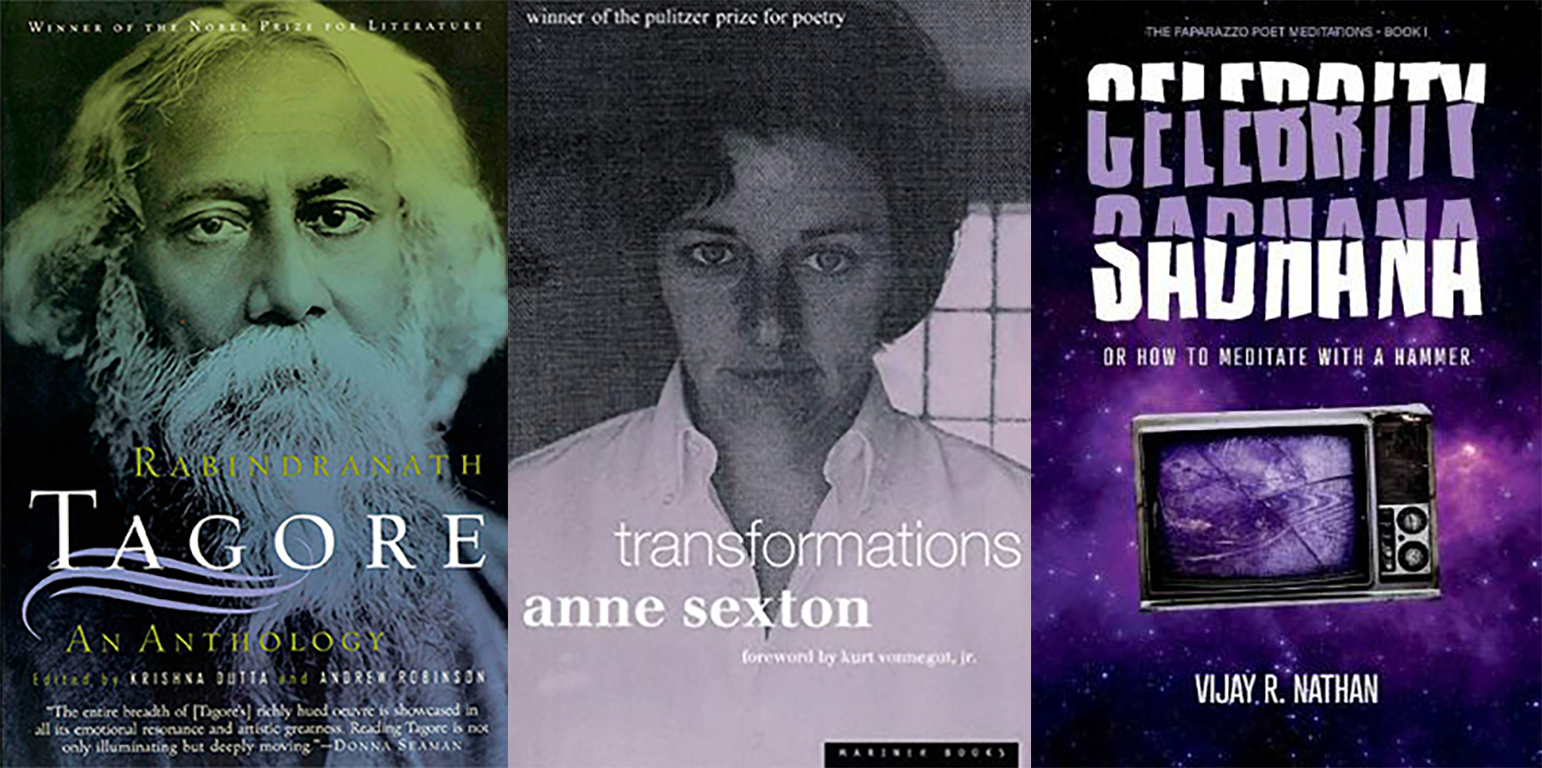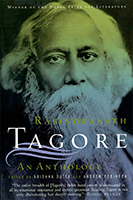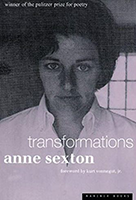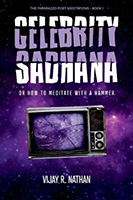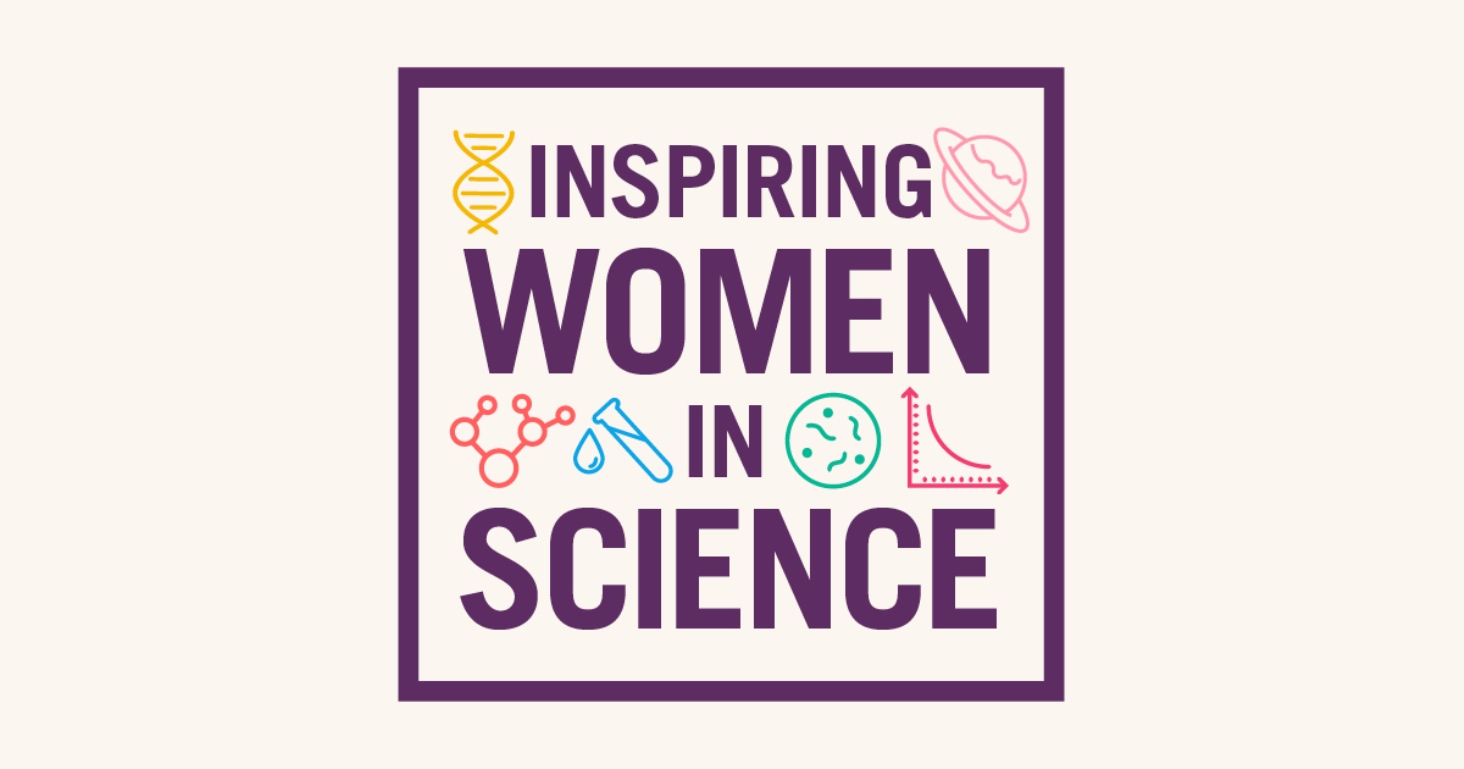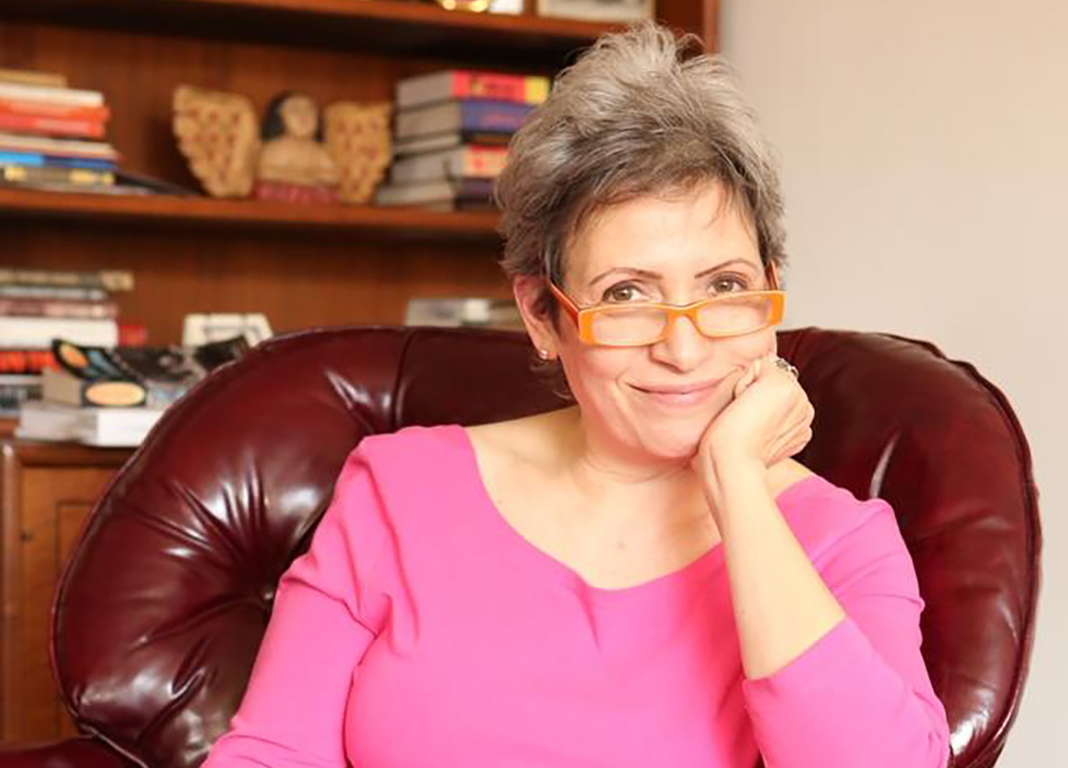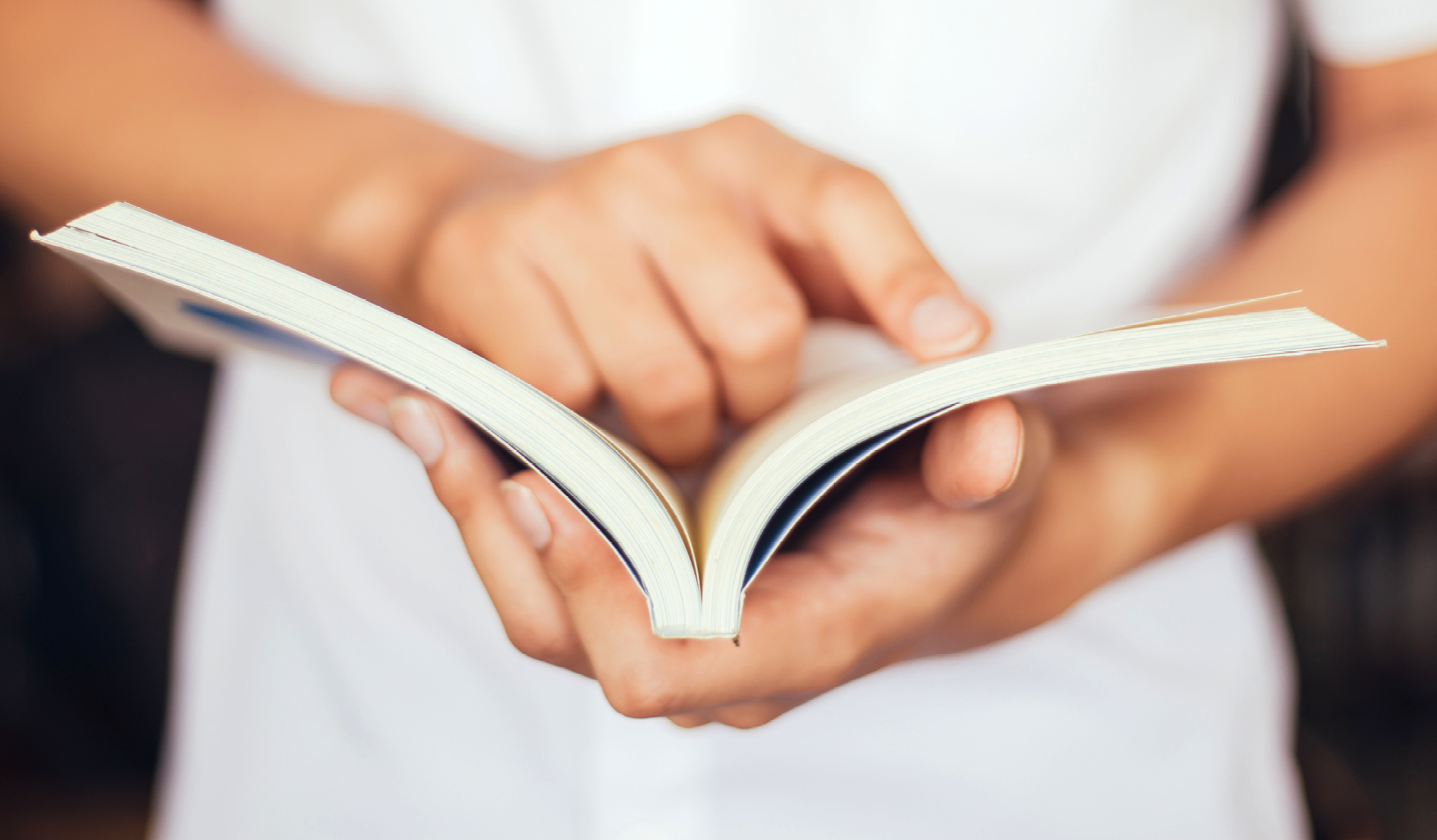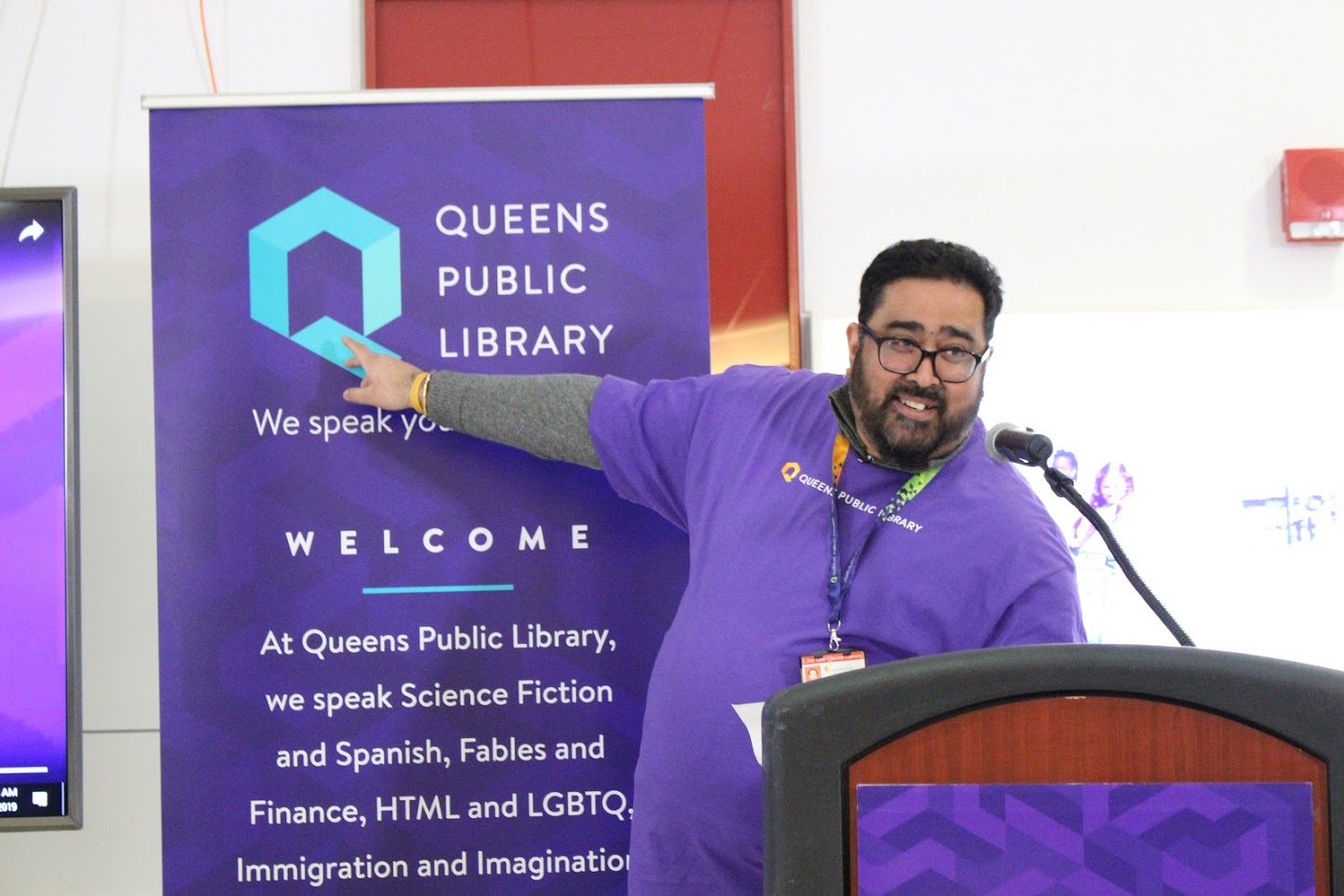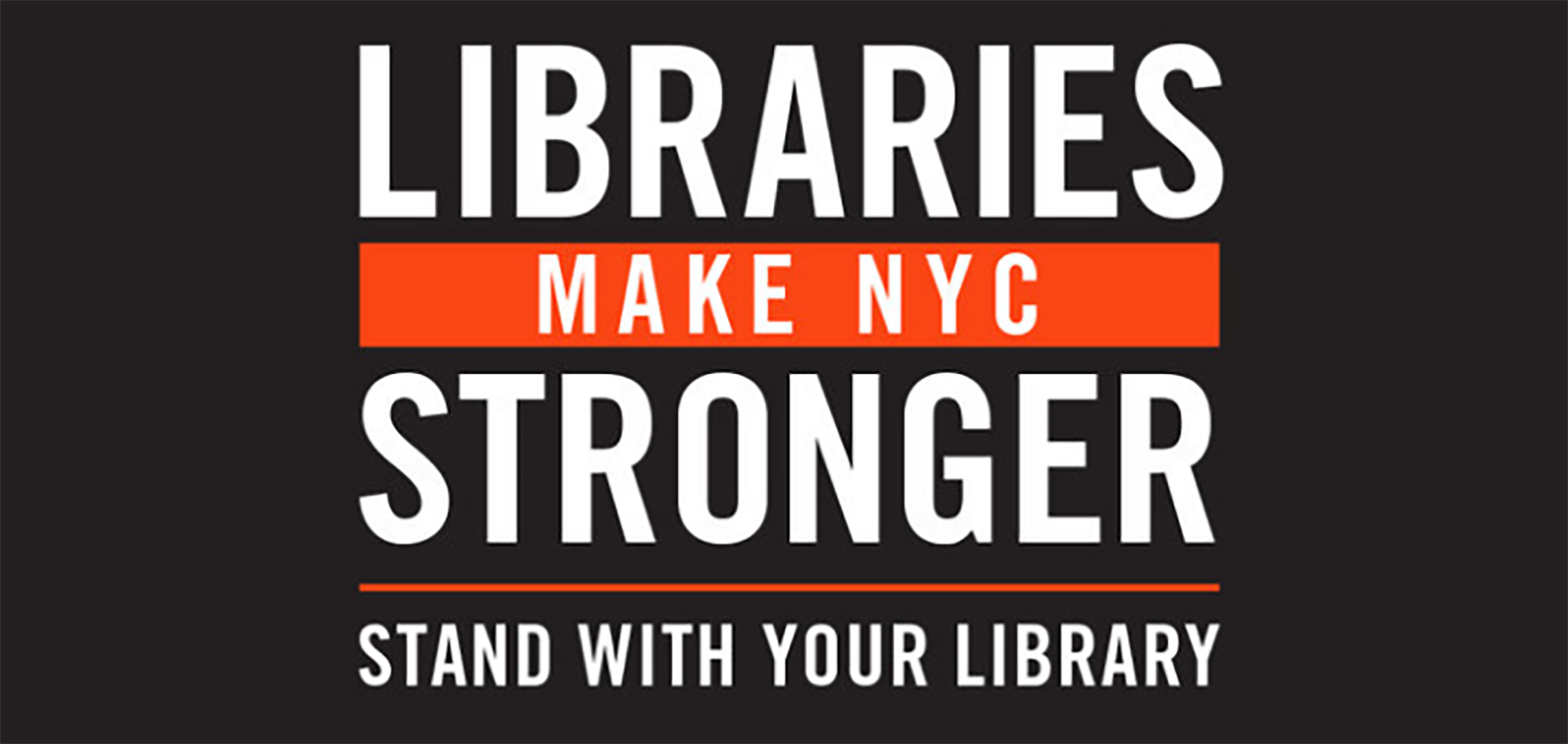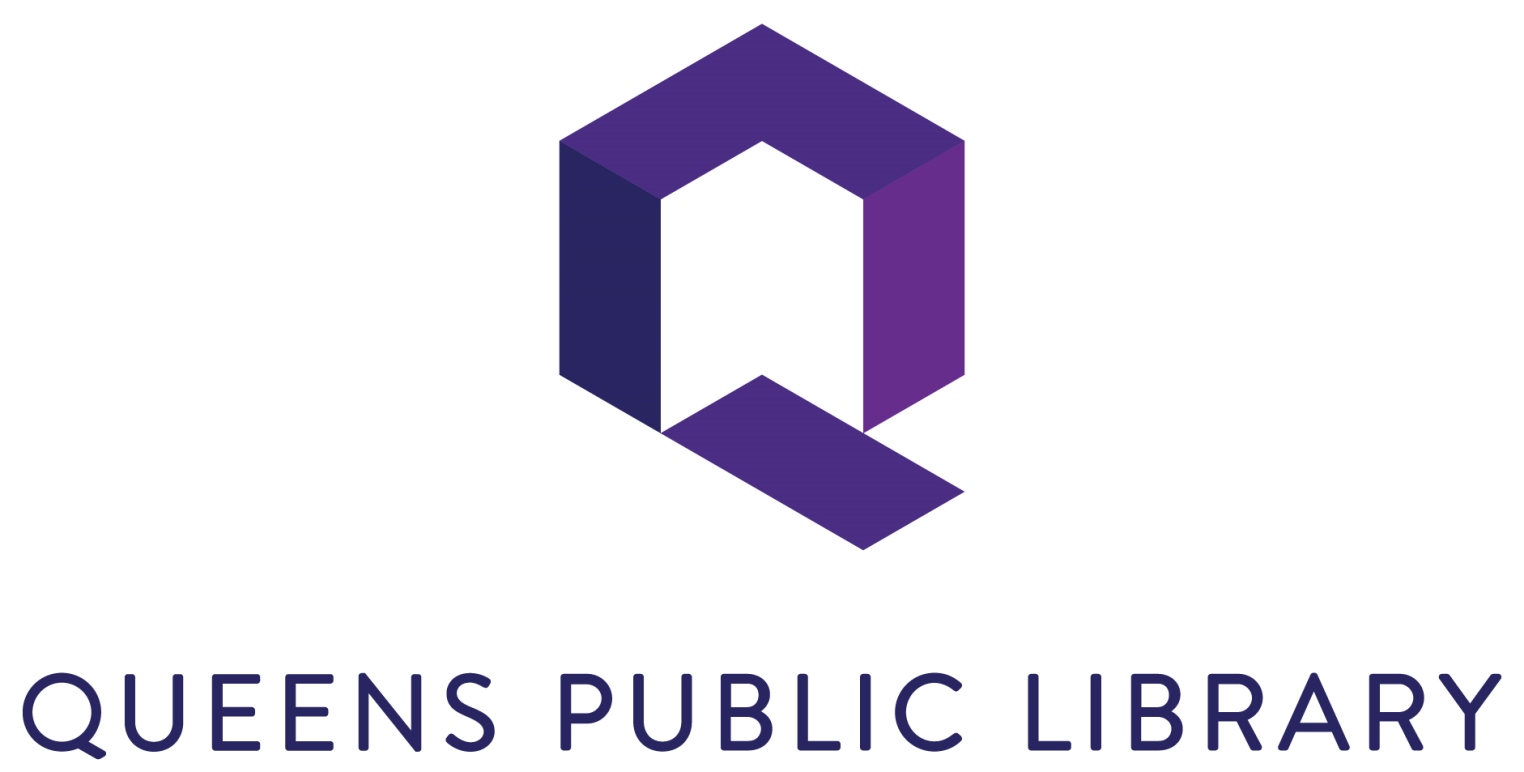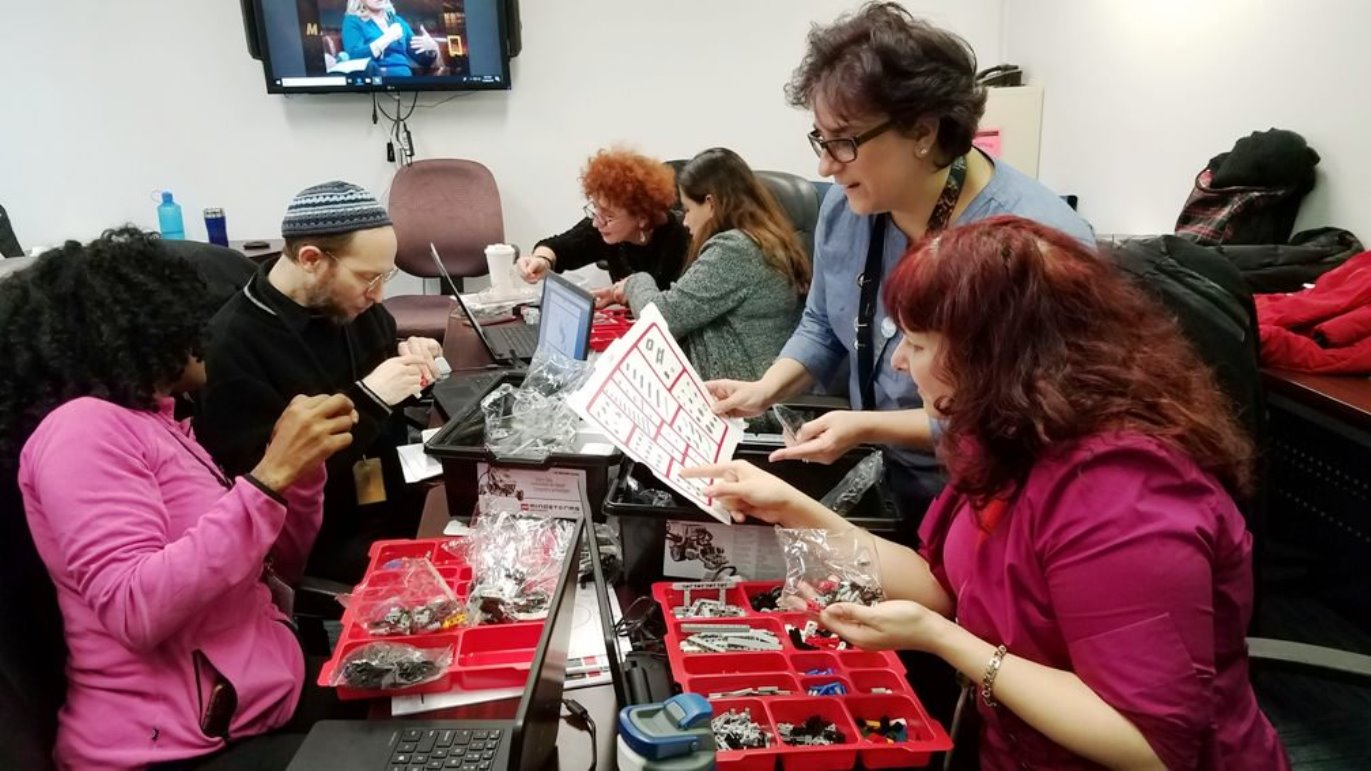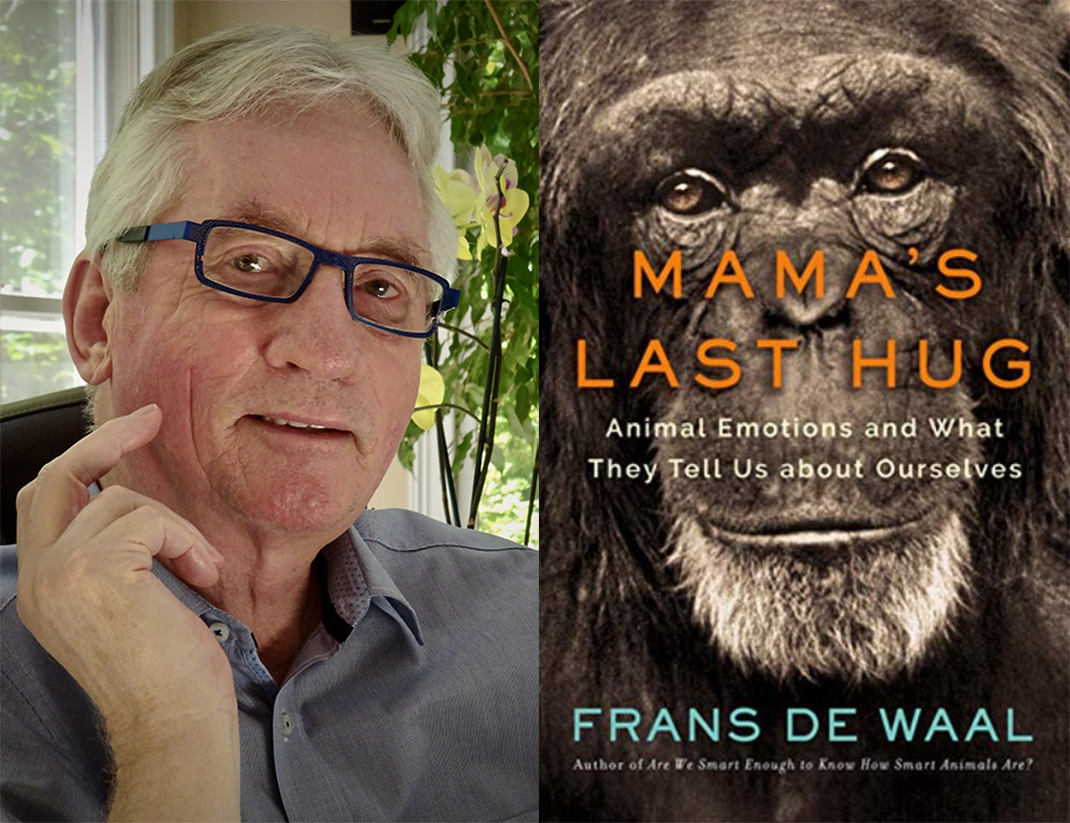Since April is National Poetry Month, we asked our librarians and staff members to share their favorite poems and poets. Stop by your local library to discover (or rediscover) these fantastic purveyors of verse!
“My favorite poet is Sor Juana Inés de la Cruz, and her poem that I like the most is 'You Men (Hombres Necios Que Acusais).' I admire Sor Juana because she was a rebel with a cause. At a time when women had no voice or vote, she preferred to become a nun rather than marry and be subjugated to a husband. She also cut her hair to pass as a man to go to university.”—Raynelda A. Calderon, General Librarian, Langston Hughes Community Library
“Rabindranath Tagore was a Bengali poet, short-story writer, composer, playwright, essayist, and painter who introduced new prose and verse forms and the use of colloquial language into Bengali literature, thereby freeing it from traditional models based on classical Sanskrit. He was highly influential in introducing Indian culture to the West and vice versa, and in 1913 he became the first non-European to receive the Nobel Prize for Literature. Here at Central Library we have a unique collection of Tagore's books written in world languages, including his native Bengali.”—Linda Chakmak, International Languages Librarian, Central Library
“My favorite poem is 'Invictus' by William Ernest Henley. Whenever I need a boost, I think of 'Invictus' and it reminds me of how strong I am. I have such an affinity for this poem; the title alone means 'unconquerable,' or 'undefeated.' I think that is a good way to go through life, knowing that you may have some bad times, but through it all, you won't be defeated.”—Victoria Kowanetz, Children's Librarian, Seaside Library
"My poetry recommendations include Transformations by Anne Sexton, a collection that takes traditional fairy tales that we all know, but then twists the stories around to take a feminist perspective. In doing so, each story feels more shocking and relevant to today's culture. Another is Date & Time by Phil Kaye. Kaye takes the stories of his life, both present and past, and weaves them into a wonderful collection about growing up, what ties us to our family's heritage, and how we grow as individuals. Besides his written words, I would also highly recommend checking out Phil Kaye's spoken-word videos on YouTube.”—Jo-Ann Wong, General Librarian, Floating Team
“I have two poets that I really like and never get tired of: William Carlos Williams and ee cummings. What appeals to me is the altered perspective that their poems evoke and call forth, like in Williams’s 'Flowers by the Sea,' for example. The ocean, that seems so massive and immovable, sways at the top of the flower stems. Isn't that one of the powers of writing and words?”—Amy Willis, Customer Service Supervisor, Elmhurst Library
"Celebrity Sadhana, Or How to Meditate With a Hammer was a joy for me to write and to read at various venues as it combines the meditative with a wicked sense of humor that I get a kick out of each time I read it aloud to audiences. The best kind of poetry, in my mind, is the kind of poetry that's fun and engaging for both reader and writer alike. I hope you will enjoy reading this work that was sponsored by the Queens Council on the Arts as part of their New Work Grant."—Vijay Ramanathan, Assistant Community Library Manager, Forest Hills Library
"I would like to recommend two poems by the Puerto Rican poet, actor, and screenwriter Jacobo Morales. 'A Mil' is a poem about the unfortunate lifestyle we all live today...time-managed to the point that even in death we are still trying to micro-manage our own death! 'Ser Jíbaro Es Un Honor' is about the 'country bumpkins' that, no matter what country or nationality, everyone makes fun of. In Puerto Rico, we call them the jíbaro. In this poem, Morales refers to the countryside people who farm the land in a traditional way, but the jíbaro is a subsistence farmer, and the iconic reflection of the Puerto Rican. Morales points out how both white-collar and blue-collar Puerto Ricans are now identifying themselves as jíbaros, in proud connection with their history, culture, and dignity.”—Roberto Segura, Assistant Library Custodian, Community Library Services
Thank you to our staff members for these great recommendations—and here are even more poetry picks!
This Women’s History Month, we celebrated Inspiring Women in Science with ways to learn more about women who have achieved great things in different scientific fields—these included bingo and trivia games at our branches. We also distributed science activities at all of our branches that customers could try at home and in their libraries to learn about animal habitats, buoyancy, genetics, geometric shapes, and flight.
Even more exciting, we brought women in science to the library to give talks about their work and the challenges they face in their careers as women in male-dominated fields. Our speakers included science storyteller Moiya McTier, biodesigner Danielle Trofe, science educator Beth Tuck, several professors, and many more.
Moiya McTier reflected on her experience, “I was able to share my story, some of the life lessons I've learned, and my astrophysics research with an incredibly curious audience. At the end, I left the audience with some advice for incorporating more science into their lives.” She also had advice for how you can feel more like a scientist and honor the spirit of the Inspiring Women in Science initiative: “You can participate in citizen science with the Zooniverse project, stay informed about recent research by following science communicators on social media, spread knowledge about women and people of color scientists to inspire the next generation, and use the scientific method in your daily lives.”
Biodesigner Danielle Trofe, who led workshops on creating planters, says the most rewarding aspect of visiting the library was “seeing how excited the kids got when they were learning about mushrooms and mycelium and the care they took when making their planters.” Her goal was to demystify the science side of biomaterials and make biofabrication feel very approachable, regardless of age or experience. She was encouraged by the number of questions that kids asked and their curiosity about the content and exercise.
Trofe uses online library tools to find the research papers that her work requires. But her perspective on libraries shifted after her visits to Queens Public Library. Now, she believes that “the brick and mortar meeting space creates accessible, placed-based learning as well as cultivates community, providing services that are locally attuned to its constituents.”
Beth Tuck from Genspace presented workshops on DNA through examining strawberries. “The most rewarding part for me is always seeing the joy of discovery when the kids finish the experiment and see what DNA looks like for the first time—it is truly amazing.”
Tuck advises young women interested in pursuing science to “lean on their sisters…bring each other up.” Her own career path “has been a very interesting journey so far, from growing up in a small community to pursuing graduate school research in molecular biology and genetics to changing gears and now working in STEM education and community engagement. This stuff is amazing and gives me life every day...The important thing is not giving up, and understanding when to change direction and try something new to solve those challenges.”
Dr. Shruti Naik, an assistant professor at NYU Langone Health, focuses her research on stem cells in health and disease. She is recognized for her work in demonstrating that skin stem cells retain a memory of previous inflammatory experiences. Her work may hold the key to improving our ability to fight against diseases like cancer.
Dr. Naik finds libraries to be sanctuaries away from the hustle and bustle of New York City. She’s inspired by the beautiful books that she finds there and thinks of libraries as a place where she can catch up with herself and her thoughts. She enjoyed her visit to QPL, saying that even the pre-teens in the audience “put down their phones to talk about science. I always think as a scientist that most people deem science too boring or nerdy, but everyone in the room was so enthusiastic about what we study and the new discoveries happening today.”
Thank you to all of our wonderful visitors for sharing their knowledge and inspiring our library communities!
In honor of National Poetry Month, and Immigrant Heritage Week, we are very pleased to share some poems from the outgoing Queens Poet Laureate, Maria Lisella.
Maria has served as Queens Poet Laureate—the person charged with promoting a love of poetry and literacy throughout our borough—since 2015.
“I have been honored to join the illustrious list of poets who have been Queens Poets Laureate, especially the late Stephen Stepanchev, who was one of my professors at Queens College, and Hal Sirowitz, who is also a charter member of brevitas, an online poetry circle,” said Maria. “I am also delighted that Queens Public Library has supported this campaign.”
“Queens epitomizes what New York City has always been: the first stop for immigrants in their quest for a new life. Today, it is easier for merchandise and goods to cross borders than people,” she continued. “Poetry is linked to human movement because all of our stories are renewed by the flow of cultures; and Queens has myriad stories to tell, a subject I like to revisit in my work.”
"On behalf of QPL and our customers, I want to thank Maria for sharing her talent and passion for poetry across our library system,” said Queens Public Library President and CEO Dennis M. Walcott.
Applications to become the next Queens Poet Laureate can be submitted beginning April 29.
Congratulations and thank you for your service, Maria!
L’Americana, The American
by Maria Lisella
The women's talk moves to Women's Talk:
"And your clothes, they cannot be from America.
Real Americans wear pink and blue
And sox with sandals like Germans."
New York is not L'America
There, the national color is black,
But not for mourning, I try to say.
I don't look like a real American,
Because I remain a Mediterranean hybrid
With the suspicious heart of a peasant
On both sides of the Atlantic.
Small Victories
by Maria Lisella
Your mother loved words
Sent you to learn “real” Italian
to forget the staccato Calabrese
iddu, idda, ghista, ghistu.
You cocked your ears
to other dialects, studied Dante.
She wanted you
to become “a type-a-writer.”
You rebelled, wanted
to work with your hands.
Sketched haute couture designs
from window displays.
Cut and sewn from remnants
your cousin smuggled
from sweatshops.
Stayed up all night
creating head-to-toe ensembles.
A bonbon of a hat added
inches to your small frame.
Your white polka dot dress
billowed at the sleeves,
a heart-shaped neck dipped toward
a hip-hugging skirt over curves,
delirious with the victories your hands
promised and delivered in the night.
Immigration
by Maria Lisella
On a one-lane road
I drive through southern Sicily.
Green groves spiked
with golden globes
Christmas ornaments
skinned in summer
soaked in syrup
sold from barrels
at roadside stands.
Preserved lemons,
Morgan lemons
thick-skinned lemons
with salt sprinkled
on the back of my hand
to lick, suck, sip beer.
In the shade of emerald leaves
stick figures
bend, reach, toss lemons
a euro for five kilos
in crates, compressed
to remove oil, pulp, fragrance,
Lemons, end
in a bell jar
on my kitchen counter
in New York City.
April 18, 2019 - Queens Borough President Melinda Katz, in partnership with Queens Public Library and Queens College, today announced the launch of an open call for applications for the next Queens Poet Laureate, a prestigious position charged with promoting a love of poetry and literacy throughout the borough. The announcement comes in time for National Poetry Month, a celebration of poetry that takes place each April.
Applicants for the unpaid position of Queens Poet Laureate must be published poets and residents of Queens. The winning candidate will be a talented writer who can also demonstrate that she or he has a compelling vision for the role.
“As the most diverse county in America, Queens seeks a Poet Laureate whose work strikes a universal chord,” said Melinda Katz. “The Poet Laureate will also demonstrate an abiding affection for Queens and an ability to convey that affection through inspiring, thought-provoking poetry.”
“Poetry is one of many languages we speak at Queens Public Library, and this partnership with the Borough President will help keep us fluent,” said Dennis M. Walcott, President and CEO of Queens Public Library. “It is a privilege for QPL to amplify the voice of the Queens Poet Laureate, and a gift for our customers. On behalf of QPL and our customers, I want to thank the outgoing poet laureate, Maria Lisella, for sharing her talent and passion for poetry across our library system.”
“Our hope is that the Queens Poet Laureate will be able to share the beauty and impact of Queens’ diversity of cultures, languages, and people, and that what they write and express will resound among Queens residents as well as with readers across the entire globe,” said Félix V. Matos Rodríguez, Ph.D., President of Queens College.
Applications for the Queens Poet Laureate position will be available at www.queensbp.org/poet and may be submitted beginning April 29, 2019. Applications must be submitted by 5:00 PM EDT on May 31, 2019 to be eligible for consideration.
The selection process is open to published poets who currently reside in Queens and have lived in Queens for at least the past two years. Applicants are expected to submit a writing sample of up to ten pages of their poetry, along with an essay of up to 500 words on why the applicant wants to be the next Queens Poet Laureate. Applicants must also submit a one to two-page résumé focused on their poetry-related work (such as the publications where their work has appeared, along with any public readings they have done and any grants, fellowships, awards or other poetry-related recognition they have received).
The next Queens Poet Laureate will be installed by Borough President Katz during a public ceremony at Queens Borough Hall. During his or her three-year term, the Queens Poet Laureate is charged with promoting an appreciation of poetry throughout the Borough of Queens. Examples of outreach include readings at public schools, libraries, community centers, parks and borough arts events.
The past Queens Poet Laureates are as follows: Maria Lisella (who served from 2015 to 2018), Paolo Javier (2010-2014), Julio Marzan (2007-2010), Ishle Yi Park (2004-2007), Hal Sirowitz (2001-2004) and Stephen Stepanchev (1997-2001).
About the Judges
Outgoing Queens Poet Laureate Maria Lisella and past Queens Poet Laureate Paolo Javier will serve on the five-member panel of judges who will review the submissions of those applying to be the next Queens Poet Laureate.
Also on the panel are Walt Whitman Award-winning poet Nicole Cooley, NYC Youth Poet Laureate Camryn Bruno, and Alice Quinn, Executive Director of the Poetry Society of America and an adjunct professor at Columbia University’s Graduate School of the Arts.
About the Queens Poet Laureate Administrative Committee
The process of selecting the Queens Poet Laureate is overseen by the Queens Poet Laureate Administrative Committee.
The members of the Administrative Committee are: Dr. Nicholas Alexiou, a professor at Queens College and a contemporary poet and artist; Andrew P. Jackson (Sekou Molefi Baako), the director emeritus of Queens Public Library’s Langston Hughes Community Library and Cultural Center and a member of the Board of Trustees of Queens Public Library; and Maria Terrone, poetry editor of the journal Italian Americana and a frequent visiting poet in Queens and Manhattan public schools.
Applications for the position of Queens Poet Laureate will be pre-screened by the Administrative Committee, then reviewed by the five-member panel of expert judges. The judges will select three finalists who will meet in person with the five judges and the members of the Administrative Committee, who will collectively make the selection of the next Queens Poet Laureate.
This April 2, Queens Public Library launched its Renewed Promise to the Public with a new visual identity, new tagline, new website, and new commitment to higher levels of customer service, including translation devices at every branch. Staff shared what this initiative means to them.
Mahendra Indarjit (above), Central Library manager of information access services, said, “My renewed commitment is to continue to meet the needs of the community by delivering the best customer service possible by speaking everybody’s language whether it be HTML, Python, CSS—that’s what we do here.”
Genive Purchase, Central Library assistant manager, explained, “What is so amazing about Queens Public Library is we serve such a diverse community. Our renewed promise means we are recommitting to our high customer service standards. It doesn’t matter what your gender identity is, it doesn’t matter where you live, it doesn’t matter if you’re unemployed or underemployed. We are here for you. We want to connect you to the services that you need and that is our primary goal in what we do every day.”
“So many of us here who work at QPL come from diverse backgrounds, speak different languages, and have different cultural experiences. I myself immigrated from India. Growing up we did not really have the concept of a public library…That experience has given me a unique perspective on how valuable and enriching Queens Public Library is to the community here. While the public library is always striving to serve the public and improve its service, to me the renewed promise means that we take a moment to slow down and consciously evaluate how we are doing, how we are serving," said Asha Unni, Central Library assistant manager.
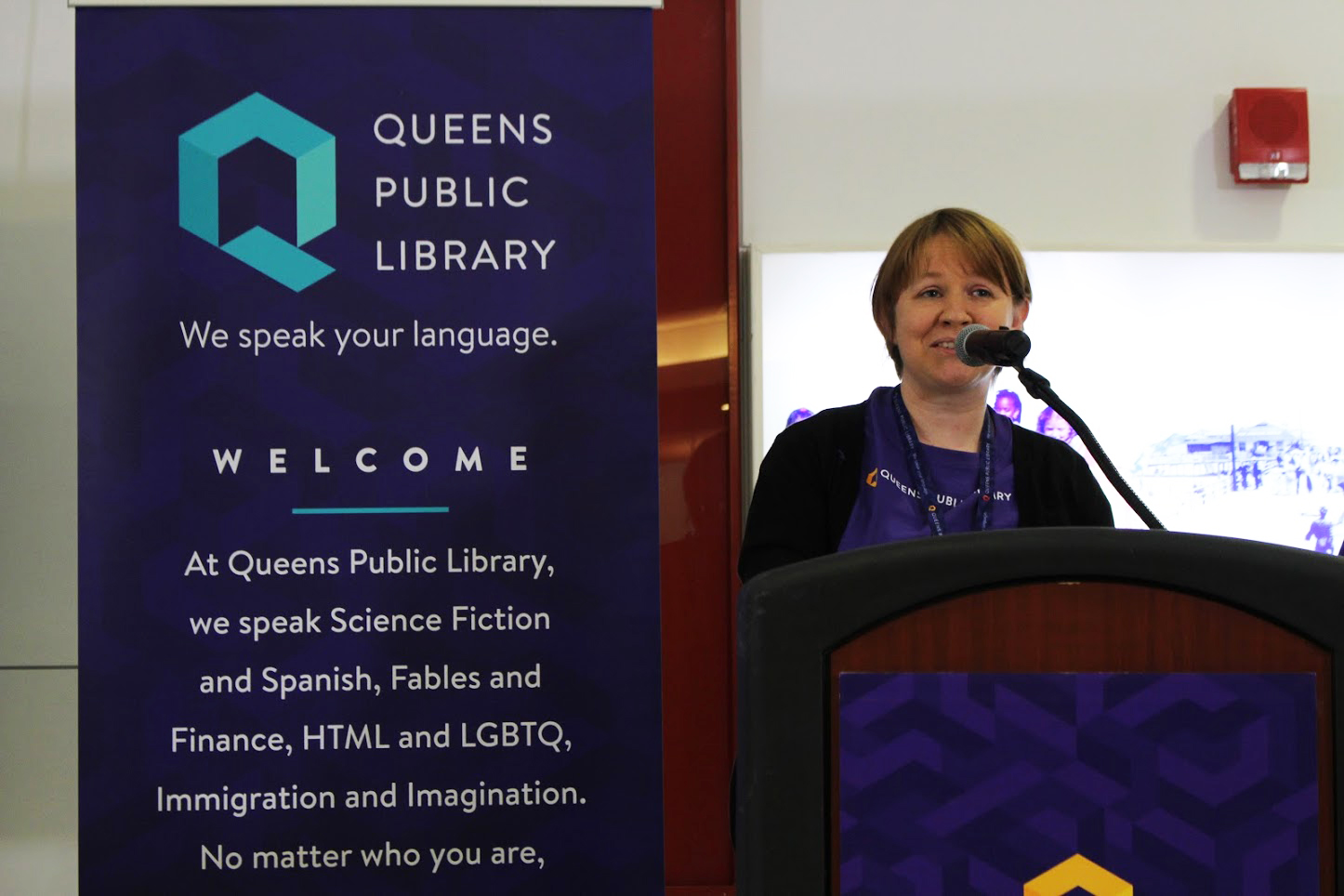
Maryanne Olson (above), the assistant community library manager at Ridgewood Library, said the tagline We Speak Your Language reflects not only the diversity of QPL’s programs, services, and communities, but also the evolving nature of library services. “The library is always changing how it speaks to its customers,” she said. “There’s never one way of doing things.”
Judith Todman, manager of unique services at Central Library, says her division speaks neighborhood history, maps, and photos as well as the languages in the international languages collections. The library, she says, means many things to different people, whether it be computers or medical information or concerts. “Our cyber center is a lifeline to our customers applying for jobs and also connecting with friends and family abroad.”
Linda Chakmak, an international languages librarian, speaks Hindi, Russian, and Turkish—and greeted the press conference on April 2 in all three languages.
Marjorie Gonzalez, another international languages librarian, says, “I’ve been a library user since childhood, and now, as an adult, I am very grateful to be able to serve in this diverse and wonderful community.”
No matter where you are going or where you come from, we speak your language. Come in to a library location near you and find out about all of the services and opportunities we offer.
For the second year, Queens Public Library has awarded the Go the Extra Mile (G.E.M.) Award to our volunteers who go above and beyond in their service and embody the Library’s mission “to transform lives by cultivating personal and intellectual growth and by building strong communities.”
Five of our volunteers have received G.E.M. Awards, and three have been recognized as Honorable Mentions. Learn more about them below.
Thank you to them, and to every QPL volunteer, for their service!
2019 G.E.M. Volunteer Award Recipients

Lingling Huang, Homework Helper/Activity Assistant, Queensboro Hill Library
"Lingling is amazing: she's our Homework Helper volunteer, but she's so much more than that. She's been our community liaison here at Queensboro Hill, whether it's helping with translation so that parents can take part in our family programming, acting as a second (or third) pair of hands during a popular program session, or setting up a homework help table during the week. Lingling's help and connections to our local public elementary school have also allowed us to restart our class visits and relationships with PS 120. She is a friendly, calming influence at Queensboro Hill. We are thrilled to have her as part of our QPL family!"—Rosemary Kiladitis, Assistant Community Library Manager, Queensboro Hill Library

Fran Kipnis, Queens Memory Project Interviewer
"Fran brings a wonderful combination of passion, communication skills, curiosity, and empathy to her volunteer work with the Queens Memory Project. She has conducted well over a dozen interviews for us, mostly as part of a special project we’re conducting to capture Queens LGBTQ+ History. As a small team, Queens Memory depends upon our volunteers to represent us, often in non-library settings around the borough. Fran visits senior centers and political club meetings, and meets with elderly interviewees who quickly feel comfortable sharing their life stories! She knows that much of history is left unrecorded and that underrepresented voices not only deserve the honor of being on the record, but also benefit our future understanding of events and places from the past. Queens Public Library researchers will be thanking her in the future for her contributions."—Natalie Milbrodt, QPL Metadata Services Coordinator & Director of Queens Memory
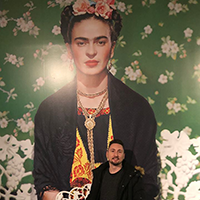
Matthew Kolbusz, ESOL Conversation Group Leader, Broadway Library
"In 2018, Matthew inherited the Broadway ESOL Intermediate Conversation Class from a previous volunteer. Within 1 month, he tripled attendance. Within 1 year, attendance rose 900%. Word has spread and eager new students continue to join weekly. Matthew beams with pride when he speaks of his students. He is highly punctual—not deterred by blizzards, sub-freezing temperatures, and endless M/R train delays. He continually grows and evolves his lesson plans to stay current and relevant. Passersby of his classroom overhear the uproarious laughter of students acting out scenarios that are relatable, fun, and whimsical. His students are fiercely loyal and insist to anyone who will lend an ear that Matthew is the 'very best ever!' They are drawn not only to the depth of his lesson plans, but just as equally to his charm, warmth, ebullience, grace, and humanity."—Abigail Goldberg, Assistant Community Library Manager, Broadway Library

Ayoola Silvera, Correctional Services Volunteer
"Ayoola volunteers her time and makes the lengthy commute from the Bronx in order to assist with library services at the Anna M. Kross Center at Rikers Island. During service, she is always respectful towards clients and offers excellent readers’ advisory, helping patrons select the best reading materials to suit their tastes and interests. She often brings thoughtful selections of books and magazines to donate to the collection. She is always on time, patient, and helpful. Ayoola has become such a dependable and consistent presence during service that patrons have come to rely on her knowledge of the collection. In a difficult environment like a correctional facility, the presence of a such a friendly, approachable, professional, and intelligent volunteer is a wonderful boon!"—Kim McNeil Capers, QPL Director of Community Engagement

Yiding Yang, Chess Instructor, Poppenhusen Library
"Yiding is a young man who is truly dedicated to Poppenhusen Library and its customers. Every Thursday, rain or shine, he travels to Poppenhusen to teach children the time-honored game of chess. Yiding has never once been late for his lessons, and has gained a loyal following of students eager to learn. He instills the values of forward thinking, self-reliance, and self-confidence through his chess lessons. The children he teaches come away feeling better about themselves and their parents are also pleased with his results. Yiding has made Poppenhusen Library a very popular place to be on Thursday evenings. Every week, he can be counted on to walk in with a warm smile; infectious, happy energy; and a willingness to help children find the value in themselves that they then take and spread outside of the library system."—Miquel Rowell-Peterson, Customer Service Supervisor, Poppenhusen Library
2019 G.E.M. Volunteer Award Honorable Mentions
Leon Isakov, CUNY Service Corp. Intern, Job & Business Academy
"Leon, who is wrapping up his second year majoring in Biology at Queens College, is currently fulfilling his CUNY Service Corp. internship with the Job & Business Academy at Central Library. Leon has quickly established himself as a competent and reliable individual. So far, and successfully, he has taken on the challenge of facilitating several of JBA's Financial Literacy workshops. From day one, with great diligence and clear thinking, Leon has given his full assistance to the entire staff. He is a hands-on worker who has gone above and beyond his duties by familiarizing himself with all JBA services and creating useful documents for training future interns and employees. He is vocal about suggestions that would benefit not only the department but also our customers. All of this translates to him being a great assistant and representative of the Job & Business Academy."—Lakishia Brown, JBA Special Projects Coordinator
Vincent Haywood-Howell, Chess Instructor, Seaside Library
"Vincent has been volunteering as a chess Instructor since 2014. He has devoted his free time volunteering every week without fail after coming from his full-time Job. He comes every Monday and sets up the tables, chairs, and chess sets. He engages adults and especially kids and shows them how to play chess, step by step, in a very easy manner. As a resident of the neighborhood, almost everyone knows and recognizes him. He is a very charismatic person and has developed relationships with the kids and families here at Seaside. New families still show up on Mondays, looking for Vincent so he can teach their kids how to play chess."—Jay Dela Cruz, Community Library Manager, Seaside Library
Mitchell Lewis, Clerical Volunteer, Central Library
"Mitchell is a former participant of the Young Adult Literacy Program. He actively volunteered 2-3 times a week after class at Central Library while he was enrolled in the program, assisting with clerical duties. He always asked how he could be of more help and reached out to other departments. He tackled our task of 'going green' by digitally scanning our paper files and materials. Mitchell recently placed out of our Pre-High School Equivalency program and decided to study independently to take his HSE exam. Although he still has quite a journey ahead of him, he still shows up to volunteer every day, friendly, excited, full of stories and smiles and always willing to lend a hand. What makes me want to recognize him is that although he completed the program and no longer needs to attend classes or come to the Library, he chose to come back and still commit his free time to helping his library family."—Shayla Simpson, QPL Senior Manager of Young Adult Literacy
Posts in This Series
New poll states New Yorkers say libraries make a significant positive impact, are key to supporting progressive city initiatives, and need increased support, even as City budget cuts loom
Change Research poll shows 95% of New Yorkers say a loss of library service would impact their communities, particularly children, seniors, immigrants, and low-income families; more than half of library users said a decline in service would limit their access to books and internet
APRIL 8, 2019 – A new poll reveals that New Yorkers believe public libraries are relevant, valuable cornerstones of New York City, making positive impacts on many communities, including and especially the most vulnerable: and that a decline in library service would have real impacts.
Results of the representative online poll of over 1,000 New Yorkers conducted between March 26 and March 31 by firm Change Research come as the city’s three public library systems are fighting for necessary increases in City operating and capital funding to cope with rising costs, growing footprints, increased demands, and aging buildings.
The three library systems are asking the City for $35 million in additional expense funding in Fiscal Year 2020 and $963 million over 10 years in the 10-Year Capital Plan for full renovations, technology upgrades, and critical maintenance.
At the moment, however, libraries are instead facing an up to $16 million cut in operating funding: an $8 million cut to their Fiscal Year 2020 budgets, as well as the potential loss of $8 million in one-year City Council funding.
Any cut will likely result in a decline in hours (particularly on weekends), service, and hiring at Brooklyn Public Library, The New York Public Library, and Queens Public Library.
According to the poll results, this would be a serious loss for the people of New York City. Without libraries:
- 95% believe their communities and New York City would be impacted
- 65% of library users would have limited access to books and the internet
- 73% of respondents say children and teens in their community would have few or no alternative free out-of-school programs.
Additionally, a loss of hours could impact how many people use libraries and take advantage of their free programs, classes, materials, and more: 83% of those surveyed said they would be inclined to use libraries more or at all if they offered more evening and weekend hours.
New Yorkers can visit investinlibraries.org to sign online letters supporting restored and needed increased funding for libraries.
Other key results of the poll include:
- 95% agree that libraries further many important initiatives for New York City
- 93% agree that libraries are a cornerstone of all New York City communities
- 93% feel libraries are important to New York City
- 94% agree that public libraries are valuable
- 84% believe libraries should receive an increase in funding
- 62% believe public libraries even the playing field for New Yorkers
- 63% believe public libraries supplement public schools’ early education efforts
- 98% believe libraries benefit children
- 98% believe libraries benefit students and researchers
- 99% believe libraries benefit disadvantaged and lower-income people
- 98% believe libraries benefit senior citizens
- 97% believe libraries benefit working families
- 97% believe libraries benefit immigrants
“This poll reinforces what we already know to be true, that our public libraries are indispensable to our communities,” said New York City Council Member Jimmy Van Bramer, chair of the Cultural Affairs, Libraries, and International Intergroup Relations Committee. “That is why we must fight to increase funding for our public libraries and not accept any cuts that would scale back the essential services they provide. Libraries should never be on the chopping block.”
These results reinforce what the presidents of Brooklyn Public Library, The New York Public Library, and Queens Public Library presented at a preliminary budget hearing at City Hall on March 11: that New York City’s 217 public libraries uniquely provide all New Yorkers in all communities with equal access to education, information, and opportunity, offering not just books, internet, and other materials, but also free programs and classes addressing early literacy, digital equity, homeless outreach, immigrant services, and much more.
The three library systems have expanded services as well as their physical footprints to meet the growing needs of New Yorkers. They are also being asked to do more to support the important priorities of the City: libraries have played an increasingly significant role in early literacy efforts, support to immigrants, workforce development, and closing the digital divide.
Additionally, libraries continue to be the most active IDNYC sign up centers, and have been identified as key partners in the City’s efforts to reach all New Yorkers during the Census in 2020. The survey shows that approximately 80% percent of respondents find libraries welcoming, and 91% of respondents find staff members trustworthy. Hence, libraries will be strong partners in efforts to reach “hard-to-count” communities.
All of this work, in the face of rising costs, means that without restored and increased funding, libraries will not be able to maintain service, let alone meet additional needs. To receive the same expense funding as last year would essentially be a cut.
“I have spent a lot of time talking to a lot of New Yorkers about libraries over the years,” said Christian Zabriskie, executive director of advocacy group Urban Librarians Unite. “Even people who don't use the library themselves get upset when they think about their neighbors not being able to access a warm welcoming library. ‘Where will the kids go? Where will the seniors go?’ These are the questions they ask, not where the funding will come from. As this poll shows, we are a huge city of small villages, and our people know that the library is the welcoming hearth of their own small communities.”
Change Research conducted an online poll March 26-31, 2019 in New York City. Using its Bias Correct Engine to attain a sample reflective of the population, Change Research polled 1034 residents of New York City. Post-stratification was performed on age, gender, and ethnicity. The margin of error for this survey, as traditionally calculated at a 95% confidence interval, is ± 3.0%.
The Invest in Libraries campaign is a partnership between the city’s three public library systems—Brooklyn Public Library, The New York Public Library, and Queens Public Library—and other library supporters across the city. Since the campaign launched in 2015, the City has allocated additional funding for programming as well as critical capital dollars to help address the over $1 billion in need facing the city’s aging library infrastructure. Despite this important support, libraries confront rising costs and increased demand for more services and programs (from New Yorkers and the City). The campaign urges the City to restore and increase funding to meet rising needs, demands, and costs.
###
FOR IMMEDIATE RELEASE
Tuesday, April 2, 2019
Queens Library Changes Its Name to Queens Public Library, As It Renews Its Promise to the Public with a New Visual Identity, New Website, and Enhanced Approach to Customer Service
QUEENS, N.Y. _ Queens Library President and CEO Dennis M. Walcott today launched the Library’s “Renewed Promise to the Public,” a long-term initiative to honor and serve the diversity of the Library’s customers and communities that includes changing its name to Queens Public Library, a new logo, tagline, pattern and colors, a new website, and sharpening its focus on customer experience.
The kickoff was held at Central Library with New York City Council Member Jimmy Van Bramer, Chair of the Libraries and Cultural Affairs Committee, staff, customers and members of the Friends of Queens Public Library. President Walcott also announced he plans to visit all of QPL’s 65 locations in 65 days to welcome the public alongside Library staff.
“We want to make clear who we are, what we aspire to be and what people can expect from us whenever they walk into one of our locations, have an interaction with us, call us, or visit us online,” said President Walcott. “We are upholding a promise that requires us to define how we think about our role in fulfilling the public’s needs, how the public perceives us and the experience we are committed to delivering. The word ‘renewal’ recognizes our 123-year history and that we are constantly evolving to meet the changing needs of our communities. And we added ‘public’ back to our name to reinforce who is at the center of our work and to whom the Library belongs.”
The previous logo, an orange and yellow book topped by a wing with the tagline “Enrich Your Life” and name, Queens Library, were adopted in 2005.
“As a former employee and the current Chair of the Committee on Cultural Affairs and Libraries, I have championed the Queens Public Library for over 21 years and I am proud to help turn the page on this new chapter,” said Council Member Jimmy Van Bramer. “The new website and brand redesign is not only visually stunning, it embodies the Queens Public Library’s renewed commitment to better serving all of our diverse communities across Queens. I will never stop working to ensure that each and every public library branch across our borough is well-funded and thriving.”
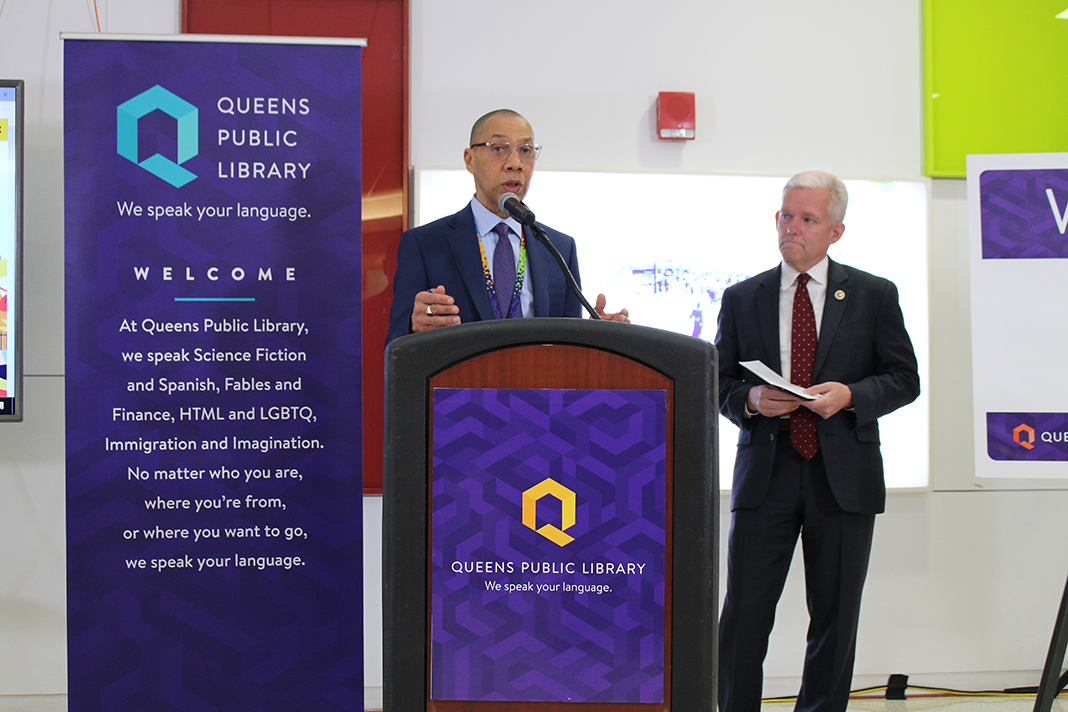
Queens Public Library President and CEO Dennis M. Walcott with New York City Council Member
Jimmy Van Bramer.
"The newly renamed Queens Public Library is one of our borough's most beloved and treasured institutions, as each of its 65 locations across Queens uplift and empower residents of all ages,” said Queens Borough President Melinda Katz. “This rebranding initiative will further boost the Queens Public Library's standing in our borough, while affirming the collective promise of its branches as community centers of literacy, learning and culture that prioritize the growing families of Queens.”
QPL’s main color is now purple, a color associated with some of the qualities QPL seeks to cultivate, such as wisdom, creativity, dignity, and ambition, and a secondary palette of colors highlights the vibrancy and diversity of the public the Library serves.
The new tagline is “We speak your language.” It means QPL not only speaks Spanish, Chinese, Bengali, Russian, Greek and many other tongues, but also imagination, tech, history, LGBTQ, HTML, finance, non-fiction, science fiction, story time, chess, teens, opportunity, and many other interests and pursuits. It makes clear that the Library is here for everyone, understanding what their needs are and helping them pursue their goals.
The new logo is a Q comprised of tilted pieces that celebrate the many diverse perspectives of Queens Public Library, its resources, programs and services, and communities. It uses two- and three-dimensional space to express QPL’s physical and cultural characteristics.
In two dimensions, the mark is the letter Q, referencing the Library’s name and the borough of Queens. In three dimensions, it houses an open book, an open doorway, and a welcome mat, extending QPL’s promise and welcoming everyone.
To help ensure all QPL speaks each person’s language, the Library is providing all staff with implicit bias workshops. It also is planning internal equity, diversion and inclusion dialogues as well as cross-cultural training.
“Our ‘Renewed Promise to the Public’ is not just about words,” President Walcott said. “It is about helping people get where they want to go in their lives by working hard to understand where they are coming from.”
All QPL locations now have tablets dedicated to Google Translate so staff can have conversations in multiple languages with customers. The Library also will offer another type of translation device at every site and will soon pilot a language line service offering telephone interpretation at several locations.
The new website is faster, easier to navigate and search, clearer—with more contrast to better meet ADA compliance, can be translated in over 80 languages and has a responsive design that will work on PCs and mobile devices with different screen sizes. It features Google Maps integration, so that mapping and directions are available in the “Locations” section of the website.
“This effort makes absolutely clear that the diverse communities of Queens will remain at the heart of everything Queens Public Library does,” said Queens Public Library Board Chair Haeda Milhaltses. “The new website and identity are as beautiful as they are evocative of what the Library is about, and I could not be prouder to serve this incredible institution. On behalf of the Board of Trustees, I want to congratulate QPL's team for their hard work and vision for the Library now and for generations to come.”
###
Queens Public Library is one of the largest and busiest public library systems in the United States, dedicated to serving the most ethnically and culturally diverse area in the country. An independent, non-profit organization founded in 1896, Queens Public Library offers free access to a collection of more than 5 million books and other materials in multiple languages, technology and digital resources, and more than 87,500 educational, cultural, and civic programs a year. It consists of 65 locations, including branch libraries, a Central Library, seven adult learning centers, a technology lab, two universal pre-kindergartens, and two teen centers.
Contact: Elisabeth de Bourbon, 718-990-0704 or 917-499-0867
Queens Library is developing a new program to introduce kids in our community to engineering projects that they will tackle through innovation and teamwork.
Children in grades 4-8 can join LEGO robotics teams at eight participating libraries and become part of the Queens Library Robotics League!
The League is being created in partnership with NYC FIRST, an organization that runs hands-on, project-based STEM education programs and robotics competitions for thousands of K-12 students across the five boroughs.
This past December, Queens Library staff participated in a two-day workshop presented by NYC FIRST to learn how to build and program LEGO MINDSTORMS EV3 robots.
Teams of staff members from the eight branches (Baisley Park, Bayside, Forest Hills, Kew Gardens Hills, McGoldrick, Queensboro Hill, Rochdale Village, and Whitestone) then competed in an INTO ORBIT FIRST LEGO League Challenge at the end of the workshop.
“It was so exciting to be part of the LEGO Robotics class—the challenge of putting together the robot and learning to program it relied on real teamwork between myself and my partner, children’s librarian Lucy Pastorello,” said Rosemary Kiladitis, Queensboro Hill’s Assistant Community Library Manager. “We could easily see how the kids are going to have to work together to learn and compete.”
“The instructor was so patient and knowledgeable, and really took his time teaching our group to get the basics down so we can get our kids programming,” she continued. “And the INTO ORBIT Challenge wasn’t about winning; it was a glimpse into what the kids will need to do in competition—and a great teambuilding exercise!”
The Queens Library Robotics League is made possible with a grant from the Queens Library Innovation Fund. Created by the Queens Library Foundation, the fund supports innovative projects and ideas that advance the goals and spirit of the Library’s strategic plan.
Please contact one of the participating libraries for more information about joining the Queens Library Robotics League.
We’re excited for the future of robotics at the Library!
This is just one of the great stories you can read in the March/April 2019 issue of Queens Library Magazine. Pick up a copy today!
Frans de Waal’s new book about animal and human emotions has been starred by Booklist, Kirkus, and Publishers Weekly. While he is a prolific scholar, de Waal grew up in a town that had no library.
He did have a small set of books at home that he returned to again and again, especially one describing the behavior of animals. He loved this book, which perhaps planted a seed for his current career as a primatologist and ethologist.
De Waal learned to use the library when he was a university student. Now he reads primarily articles in scientific journals in his role on the editorial boards of many journals and as chief editor of a journal on animal behavior. His new book, Mama’s Last Hug: Animal Emotions and What They Tell Us about Ourselves, is about something that used to be a taboo topic. De Waal says we know much more now about animal emotions than we ever have. He summarizes his own work on primate emotions and reviews other fascinating knowledge in this book.
De Waal argues that there are no uniquely human emotions: “All of our emotions can be found one way or another in other species, especially those close to us.” The book suggests that continuity between humans and other species is all-encompassng. “Emotions are like organs,” de Waal says. “There are no organs that we can do without and there are no organs that are unique to us. We share all of them with other vertebrate animals, from frogs and rats to elephants. No exceptions.”
The author’s evidence for his conclusions is largely based on primate facial expressions. He notes that “Charles Darwin concluded long ago that if apes use expressions similar to us under similar circumstances, the underlying emotions are probably similar, too.” Apes laugh when tickled, pout when disappointed, and frown when angry, engaging the same facial muscles under similar emotional circumstances. De Waal dives into the life of Mama, a famous alpha chimpanzee who lived in the Netherlands. When she died at age 59, her last hug with a professor she was close to was filmed and went viral on the Internet.
De Waal has a hard time pinpointing how and when his own love for and interest in animals began—he has always liked them and kept animals since he was a child. Most of his favorite writers are the popularizers of biological science, such as Konrad Lorenz and Desmond Morris, as well as modern scientists like E.O. Wilson. But in writing this book he was mostly influenced by Charles Darwin, whose book on animal emotions was largely forgotten for a century because animal emotions were not taken seriously by science. Now, he says, everything has changed and the field is once again respected. Other thinkers he discusses in Mama’s Last Hug include Paul Ekman (who writes about human facial expressions), Jaak Pankseep (who writes about animal emotions), Temple Grandin, and Jane Goodall.
He reads widely, including Haruki Marukami, Game of Thrones, and history books. He says the goal of all scholarly reading should be to build knowledge that is comprehensive and deep, not based only on recent writing from the past decade. For those who don’t love reading, he hopes they will find one book, whether nonfiction or novel, that hooks them. “There is no richer experience than absorbing a compelling text,” he says, “whether it tells a story or reviews a topic. You will forget time and expand your horizon.”
Mama’s Last Hug: Animal Emotions and What They Tell Us about Ourselves will be published in March and will be available at Queens Library.
